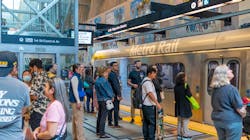L.A. Metro celebrates opening of Regional Connector
The Los Angeles County Metropolitan Transportation Authority (L.A. Metro) celebrated the opening of the Regional Connector transit project at the Japanese American National Museum (JANM) on June 16. The opening ceremony, emceed by Actor, Trustee, Chair Emeritus and JANM Founding Member George Takei, featured several musical performances and a special plaque unveiling in honor of former U.S. Secretary of Transportation and Japanese American National Museum Board of Trustees Chair Norman Y. Mineta. The plaque will be installed at the new Little Tokyo/Arts District Station.
Mineta, a dedicated member of the Japanese American Community, worked closely with L.A. Metro in securing the financing for the Regional Connector at the federal level. During his time in Congress, Mineta championed legislation promoting and furthering justice. Today, all public transit buses are universally accessible because of his leadership in shaping the 1990 Americans with Disabilities Act. He was also a co-sponsor of the Civil Liberties Act of 1988.
“It’s finally opened! Los Angeles County residents now have three gorgeous new underground stations to help them travel easily across L.A. County and readily reach more downtown LA locations via Metro rail,” said Glendale City Council Member and L.A. Metro Board Chair Ara J. Najarian. “What better way to celebrate the opening than with the unveiling of a plaque dedicated to Norman Y. Mineta, a national treasure and someone whose many worthy accomplishments played a crucial role in the transportation industry. Mineta’s legacy will continue to live on for those who pass through the Little Tokyo/Arts District Station.”
The 1.9 miles of new track laid allows light-rail trains to travel between Union Station and the busy 7th St./Metro Center Station in downtown LA’s Financial District. Bridging the gap allows L.A. Metro to merge the hook-shaped L (Gold) line with the A (Blue) and E (Expo) lines, creating two serpent-like train lines where there were once three. With the opening of the Regional Connector, riders will have access to three new underground stations:
- Little Tokyo/Arts District Station, where riders will have easy access to historically rich and vibrant neighborhoods and cultural institutions.
- Historic Broadway Station features two nationally registered districts: The Broadway Theater District, with 12 original theaters within seven blocks, and Old Spring Street, known as the original Financial District of downtown LA.
- Grand Avenue Arts/Bunker Hill Station connects riders to downtown's performing arts institutions, museums, fine dining experiences and more.
“For the first time since the Blue Line opened over 30 years ago, it will now provide a seamless, single-seat connection from downtown Long Beach to Union Station, Pasadena and beyond,” said L.A. County Supervisor and Second Vice Chair L.A. Metro Board Member Janice Hahn. “This isn’t just an infrastructure or rail project – this is going to transform how people all across L.A. County get to jobs, schools, the doctor or even just a day at the museum.”
Riders can now visit cultural events and venues in downtown Los Angeles, public parks and other major attractions. The new underground stations will offer easier access to medical facilities and jobs and commerce centers throughout the city. Many of the key destinations are within walking distance of the new underground stations, including the Japanese American National Museum, Million Dollar Theater, the Walt Disney Concert Hall, The Broad, and Museum of Contemporary Art, Los Angeles.
“With the Regional Connector’s opening, more people and communities across the region will have a faster, easier L.A. Metro ride, all while L.A. Metro continues its work to make the experience safer, cleaner and more welcoming for todays and future riders, said L.A. Metro Board Member and L.A. Mayor Karen Bass. “I know so many people have worked hard to bring the Regional Connector online, and I intend to build on those efforts alongside my colleagues on the L.A. Metro Board of Directors to make sure our transit network is a world-class system that works for everyone.”
“The Regional Connector ushers in a new era of equitable transit and investment that connects more Angelenos to convenient, fast and reliable rail transit options. With this new system integration and three newly adorned stations, Angelenos have new high-quality transit options to get to civic spaces, cultural destinations, public parks, events and neighborhoods throughout L.A. County,” said L.A. County Supervisor Hilda L. Solis. “Our returning and new riders will have easier access to medical facilities, job and retail centers throughout Los Angles without the burdens of traffic delays, parking and fueling costs.”
The Regional Connector line was designed and built with the help of community input and local voices. In addition, L.A. Metro notes the project benefited from L.A. Metro’s Board-approved small business mitigation programs: The Business Interruption Fund and Eat Shop Play, which helped support small businesses in the areas along this project during construction. The Business Interruption Fund provided support for businesses around the Little Tokyo/Arts District and History Broadway stations- $3.3 million was awarded to 56 small “mom and pop” shops, and the Eat Shop Play program provided free marketing assistance to 102 businesses along the Regional Connector line.
“The Regional Connector is a transformative project that gives Angelenos from all over the county better access to opportunity and everything that makes living in Los Angeles great,” said L.A. Metro CEO Stephanie Wiggins. “Because of this amazing project, people from as far as Azusa will now have easier access to the beach – Santa Monica or Long Beach - and parts of east Los Angeles that were disconnected from the rail system throughout construction will now be re-connected and more accessible to residents and visitors. Thank you to all the L.A. Metro team members, contractors and workers who helped us deliver this incredible project in a safe and equitable way, and thank you to the L.A. County taxpayers, without whom none of this would have been possible.”
L.A. Metro contracted with Regional Connector Constructors (RCC), a joint venture between Skanska USA Civil West California District, Inc., and Traylor Brothers, Inc., to design and build the $1.8 billion Regional Connector.
“The completion of the Regional Connector is a big accomplishment for the Skanska team,” said Mike Aparicio, executive vice president, Skanska USA Civil’s West Coast operations. “While the project consisted of many technically complicated components, the project team was able to work through the challenges in a timely manner. We are really proud of the work we’ve done to continue to create transformational transit projects alongside L.,A. Metro for the Los Angeles community.”
The project included one of the largest caverns ever excavated in Los Angeles, and Skanska and Traylor Bros., Inc., self-performed all the mining and maintenance. The work required the use of new technology and alternative materials that the county had never used before, including:
- Excavation of 5,795 feet of twin 21-foot diameter tunnels, using a Herrenknecht Tunnel Boring Machine (TBM).
- Pioneering use of a Sequential Segmented Array system, which monitored the potential ground loss in conjunction with the TBM mining and provided real-time feedback to the TBM operator.
- Three underground stations – 400 feet in length each and varying from 40 – 112 feet in depth.
- Incorporation of HOBAS pipe, which had never been used in Los Angeles County projects before.
- Use of building information modeling models to review obstructions with station structures, appendages, foundations and existing/future utilities of all stakeholders.
“At Traylor Bros., Inc. we are proud of our track record of constructing complex, safer infrastructure and the Regional Connector is no different,” said Chris Hebert, vice president and underground division manager, Traylor Bros., Inc. “The joint team’s long and successful history of underground construction and tunneling expertise was key to this project’s success. From the technicality of the scope of work, to the safety culture from start to finish, this project is one of the most consequential projects in Los Angeles’ current transit plan.”
L.A. Metro also implemented a Project Labor Agreement and Construction Careers Policy to encourage construction employment and training opportunities during the Regional Connector project. More than 10 percent of construction workers hired by L.A. Metro’s prime contractors on the Regional Connector project were from economically disadvantaged areas, and 20 percent were hired as apprentices to start their careers in construction. PLA/CCP workers included 66 percent who were Latino, five percent African American and four percent female.
“The Regional Connector is a long-awaited promise of transit equity for Los Angeles County residents,” said First Vice Chair, L.A. Metro Board of Directors, Jacquelyn Dupont-Walker. “Bringing together Metro’s L, A, E, B (Red) and D (Purple) lines at the 7th St./Metro Center Station provides Angelenos more access to L.A.’s rich cultural landscape, with access to employment centers, faith institutions, education and entertainment hubs that help Los Angeles thrive.”
The project is expected to serve more than 88,000 riders in the L.A. Metro area and is anticipated to attract more than 17,000 new riders. The Regional Connector will shorten commute times by as much as 20 minutes.
About the Author
Brandon Lewis
Associate Editor
Brandon Lewis is a recent graduate of Kent State University with a bachelor’s degree in journalism. Lewis is a former freelance editorial assistant at Vehicle Service Pros in Endeavor Business Media’s Vehicle Repair Group. Lewis brings his knowledge of web managing, copyediting and SEO practices to Mass Transit Magazine as an associate editor. He is also a co-host of the Infrastructure Technology Podcast.

